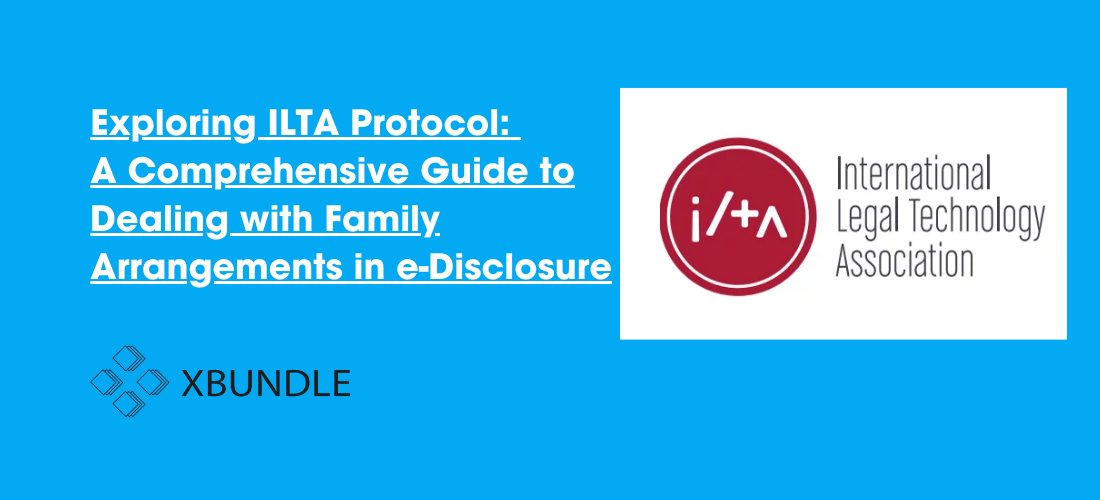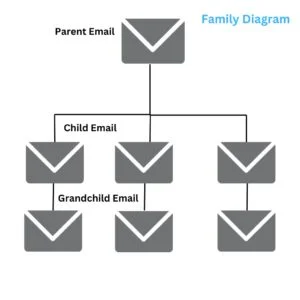Introduction
Whole families, broken families, standalone parents, orphan children, grandparent-grandchild relationships.
This isn’t an article about domestic arrangements, it is about the considerations to take into account during review and disclosure of emails and attachments as well as other documents that may have a hierarchical structure with embedded documents (attachments).
What is a Family?
We are talking about attachment relationships between documents.
If a document has attachments, embedded items, or contains other documents in any other form, it is a parent (top level item). If a document was attached to another, it is a child. A grandchild is an attachment to a child. Collectively, this is known as a family.
A decision needs to be taken on whether entire families of documents should always be produced even if some items are not individually relevant, or whether families should be ‘broken’ by producing only responsive items.
How families are treated is important not just for how the documents are reviewed as part of a disclosure workflow but also when looking at the court rules for the production of family groups. This is embodied in Practice Direction 57AD (PD57AD)[1].
Practice Direction Overview
PD57AD, originally conceived as the Disclosure Pilot in 2018[2], delineates the obligations for disclosure in legal proceedings in the Business and Property Courts of England and Wales, including aspects of electronic disclosure. Often overlooked is the specific format for exchanging electronic data, despite PD57AD mandating that parties agree on a protocol.
eDisclosure Protocol
In 2018, an ILTA Special Interest Group, led by Andrew Haslam, convened to establish an industry-standard electronic exchange protocol. This effort materialised in the ILTA e-Disclosure Exchange Protocol[3] and its accompanying Guidelines[4]. Despite many e-Disclosure vendors claiming compliance with the protocol, practical implementation often falls short of expectations. Many eDisclosure vendors have signed up to say that they are able to comply with the protocol and will produce disclosure documents in accordance with the protocol. Even when the parties do agree to adopt the protocol, however, in XBundle’s experience the resulting production set (including load files and document format) bears little resemblance to the agreed protocol.
A significant aspect of the protocol guidelines concerns the handling of family-related documents, crucial not only for review procedures but also for accurately representing family structures in disclosures. Alongside Isabel Martorell, Senior Litigation Management Lawyer at Macfarlanes, XBundle contributed to the section addressing family matters in disclosure.
Production Terminology
Before we discuss the potential options for disclosure of families, let’s first explore the concepts of placeholder, native, and image.
Placeholder
A placeholder is a blank document which identifies that while a disclosed (i.e. listed) document exists, the document itself – i.e. its content metadata – is not being produced. Typically, the placeholder would have printed on it the reason why the document is not being provided and the disclosure list would give a summary of why it is not being produced.
For Example:
- Privileged (Withheld on grounds of privilege – the document has been reviewed by a solicitor who has had control of the disclosure process).
- Not Relevant (This document is withheld on the basis that it is irrelevant to the matter and is confidential. This has been reviewed by a solicitor who has had control of the disclosure process)
Please note that where families are produced and only some of the children are Relevant and/or are Privileged then the parent will be produced as an image. This is to ensure that there is not inadvertent disclosure of withheld children by producing a native parent, from which the children that were intended to be withheld can be extracted.
Native Electronic Documents
A native document is the document in its original file format. As examples an email will be an msg or eml.; a spreadsheet will typically be an xls or xlsx; a document can be a doc, docx or PDF; Presentations are typically Powerpoint (ppt). There is a wide range of formats for audio and video files.
It is important to remember that an email will likely have child and sometimes grandchild attachments, so in disclosing a native parent email you will also be disclosing its attachments as they are part of the parent email. We deal with how this can be addressed further on in this article.
Image (PDF/JPEG/TIFF)
In the context of disclosure, the term “image” diverges from its conventional interpretation. Here, an image refers to a digital file, typically in PDF, TIFF, or JPEG format, which serves as a substitute when creating a placeholder. This is particularly relevant when dealing with documents that have been redacted, which are the redacted parent of a document family, or which belong to a document family that is not being presented in its entirety in its original form.
Alternative Options for Disclosing Families in eDisclosure
PD57AD requires the parties to avoid ‘dumping’ voluminous quantities of irrelevant documents on their opponent.[5] It is therefore important to consider whether producing entire families containing a mixture of relevant and irrelevant items may not always be appropriate.
Below, we discuss some alternative approaches to dealing with families, which depend on whether a document is Relevant, Not Relevant or Privileged. It should be noted that there is a distinction between disclosing a document – that is, including it in a disclosure list, and producing it – providing an electronic copy of that document.
Option 1 – Disclose full family, either producing or using placeholders for irrelevant items
If a full family is to be disclosed then decision then needs to be taken as to which documents to produce:
1) if one document in the family is relevant then the whole family is treated as relevant and produced in full native format; or
2) each document in the family is treated on its own merits for relevance; family members are produced only if relevant in their own right
Option 1 is the simplest way to produce as the parent document and all its attachments (other emails or standalone documents such as PDFs) are produced in their original file format.
Option 2 means there may be some family groups that contain a mixture of relevant, non-relevant and privileged documents. A placeholder would be used for not relevant or privileged documents in the family. This option would lead to producing a family is disclosed in mixed native and image format.
Where placeholders are used for child documents, or where a child is redacted, then the parent would need to be produced in image format, preferably as a PDF than as TIFF or JPEG file format. This is because a PDF provides a far better document quality and resolution than a TIFF or JPEG, and unlike a TIFF also retains the colour from original colour documents.
Images as PDF is more straightforward and gives all images in the same file format.
Privileged documents in complete families will always be replaced with a placeholder.
Option 2 – Broken family basis, disclose and produce only relevant documents.
This option a much pared back option for disclosure. Here only relevant documents are disclosed and produced., and Placeholders are used only for privileged relevant documents.. Family relationships are, however, maintained, so if a parent and child are produced as relevant, it will be apparent that the child was an attachment to the parent, rather than being a standalone email or document If an entire family is produced as relevant, it will be produced in native format, but if a family is broken, or if any member is redacted, then items will be produced in image form.
A hybrid option – Disclose complete family but produce only relevant family members (placeholders used only for privilege).
This is a third alternative, where if any child is relevant then unless it is privileged the parent email is always produced together with the relevant child(ren). This approach would be taken if it was considered desirable to provide context to the relevant children, i.e. to show they were sent under cover of a particular email. Placeholders are not needed as not relevant or privileged children or Privileged children will not be disclosed.
Similar to Option 1, if the whole family is relevant and none of the children is redacted then the whole family is produced in native form.
Where not all the children are relevant then the parent will be produced as an image so there is no inadvertent disclosure of withheld children.
In all cases, if there are any redactions to the parent for privilege or not relevant AND confidential then the parent will be disclosed as an image.
In this option the only use of a placeholder will be where the parent is privileged but one or more children are produced as relevant.
Conclusion
It’s crucial to address these considerations and discussions early on, prior to any review process. Co-operating with the opposing party is essential to establish a consensus on the implementation of the electronic exchange protocol. Ideally, this co-operative effort will result in receiving disclosures from the other party in an organised manner, rather than a mere data ‘dump’.
Bibliography
[1] From 1 October 2022, Practice Direction 57AD of the Civil Procedure Rules will apply to existing and new proceedings in the Business and Property Courts, which replaces the three year disclosure pilot.
[2] Practice Direction 51U
[3] ILTA e-Disclosure Exchange Protocol
[4] Guidelines to e-Disclosure Exchange Protocol
[5] PD 57 2.4, 3.6, 6.4 13.4



